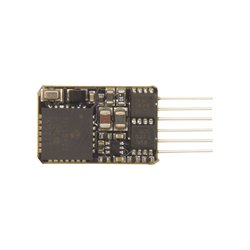Mainline Railways was a British model railway brand that operated between 1976 and 1983, introduced by Palitoy, the...
No products
Product successfully added to your shopping cart
There are 0 items in your cart. There is 1 item in your cart.
Search Tips
Easter shipping
Please note that couriers are not collecting on Friday 18th and Monday 21st April.
Orders will be dispatched on Tuesday 22nd April
What is a DCC decoder CV?
One of the jobs of a DCC decoder is to control pretty much everything that your model locomotive does, from starting and stopping to sound and lighting, the decoder gives the orders and distributes the power within the model to all the components that need it. Make no mistake, you (the operator) still give the orders from over at the controller but not directly, put simply - you tell the decoder what to do and in turn, it tells the engine.
Putting aside the technical reasons why this way of working is necessary, it is brilliant for us because it gives us a middle-manager to take care of micromanaging the locomotive. So what does this micromanager do for us that we couldn't do ourselves? after all, we used to manage just fine in the days of DC!
One of the great advantages of DCC is that you can operate locomotives independently even when they're on the same track. This would not be possible if there wasn't some form of intelligence inside the locomotive to recognise when the controller was specifically talking to it. This recognition is a major role for a decoder but that's just for starters.
In real life, different locomotive types and classes have different characteristics: they will accelerate and decelerate at different rates, have different top speeds and perform differently under different loads. All of these characteristics can be programmed into a decoder, it will then make your locomotive behave in the way in which it has been programmed.
But decoders do not come out of the box knowing which model they are to be fitted to, and certainly have no idea how the model's human owner will want them to perform, so decoders are built with programmable categories (locomotive-identification, acceleration/deceleration rate, top speed etc) configured to average factory settings. These categories are known as CVs which stands for Configuration Variables and can be programmed by the model owner through a DCC controller.
Different decoders have different amounts of CVs that can be tinkered with, however, in the main, this is not of concern to most modellers as the CVs most likely to be of interest are features of most decoders including:
- Locomotive address (so the decoder knows the controller is talking to it) this is set as 3 on most new decoders but can be changed by the owner to avoid multiple engines on a layout having the same address
- Start voltage (handy if operating an older model which may need extra power to get it going)
- Acceleration rate
- Deceleration rate
- Maximum speed
- Medium speed
It all sounds rather complicated, but fear not, although DCC controllers and decoders vary between manufacturers and complexity, they all come with programming instructions, so once you have grasped the concept of decoders and CVs then the programming is purely a matter of following step by step instruction.
For those that are still not yet confident, your models will still work just fine under their factory settings and once you have been using your DCC controller for a while to operate your trains, you'll be programming it quicker than you can say "Bill Gates"!
Click here to receive the tips weekly in your mailbox. You can unsubscribe at any time.










